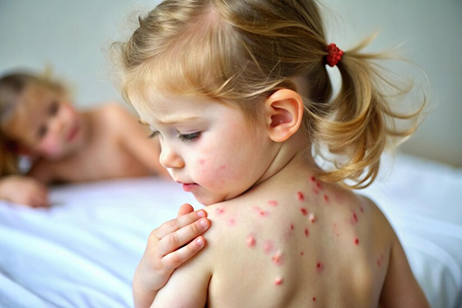Chickenpox, caused by the varicella-zoster virus, is a highly contagious illness known for its itchy rash filled with small blisters. While it primarily affects children, adults can contract the virus as well. With the introduction of the chickenpox vaccine, the incidence of this disease has significantly decreased, making vaccination the most effective means of prevention.
Symptoms of Chickenpox
Symptoms typically manifest 10 to 21 days after exposure to the virus, with the first signs being mild and flu-like.
Common early symptoms include:
- Fever
- Loss of appetite
- Headache
- Fatigue
The hallmark of chickenpox is an itchy rash that usually appears 1 to 2 days after the initial symptoms. The rash progresses through three phases:
Papules: Raised, red bumps that appear first on the face, chest, and back, and can spread throughout the body. You may see between 250 to 500 of these spots.
Vesicles: These bumps develop into small, fluid-filled blisters that last about a day before breaking and leaking.
Crusts and Scabs: After the blisters pop, they crust over and scab, usually healing within a week. It is important to note that new bumps may continue to appear for several days, meaning you could have a mix of bumps, blisters, and scabs at the same time.
The virus is contagious from 1 to 2 days before the rash appears until all blisters have crusted over. While chickenpox is generally mild in healthy children, complications can arise, particularly in infants, adolescents, and adults.
When to Seek Medical Attention?
If you suspect you or your child has chickenpox, it is essential to contact your doctor. Diagnosis is often straightforward based on the rash and symptoms, but calling ahead is crucial to prevent spreading the virus in the waiting room.
Seek immediate medical advice if:
- The rash spreads to one or both eyes.
- The rash becomes warm, red, or tender, which could indicate a bacterial infection.
- Serious symptoms develop, such as confusion, shortness of breath, severe headache, or a high fever (over 102°F)
Treatment Options
While most cases resolve on their own, treatment may be necessary to alleviate symptoms or prevent complications.
Home Remedies and Care
At home, you can help ease symptoms by:
- Taking lukewarm baths with colloidal oatmeal or baking soda.
- Applying calamine lotion to itchy spots.
- Keeping the skin cool and hydrated.
Prevention
Vaccination is the most effective way to prevent chickenpox. The CDC recommends two doses of the chickenpox vaccine for children, with the first dose given at 12 to 15 months and a second between 4 and 6 years. Adults who have never had chickenpox should also consider vaccination.
In summary, while chickenpox is typically mild, awareness of symptoms, treatment options, and preventive measures can help manage the illness effectively. Always consult your doctor for personalized advice, especially if complications arise or if you have concerns about your health or that of your child.




